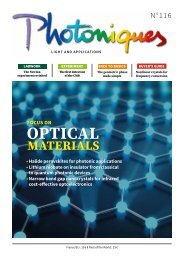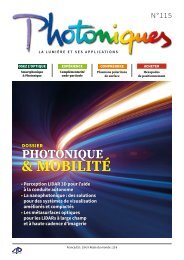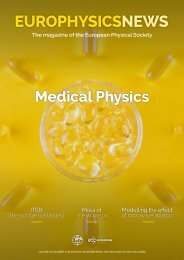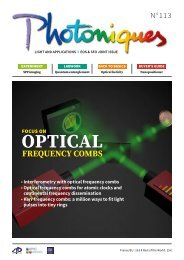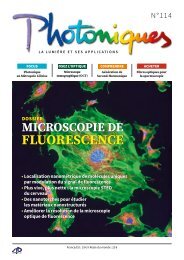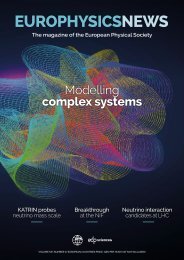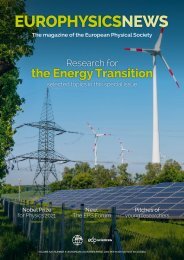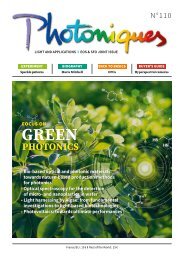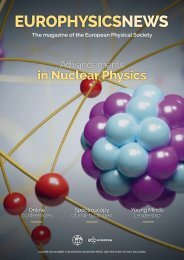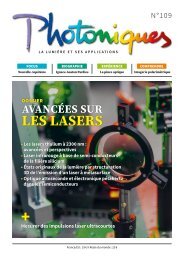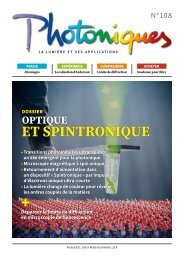Europhysics News 53-4
Europhysics News Quantum Issue
Europhysics News Quantum Issue
You also want an ePaper? Increase the reach of your titles
YUMPU automatically turns print PDFs into web optimized ePapers that Google loves.
war in Ukraine<br />
FEATURES<br />
For most Kyiv families, the foreseen war started<br />
unexpectedly on 24 th of February at 4 am by<br />
explosions and alarming telephone calls from<br />
friends. In a few hours the roads were blocked<br />
by millions of cars, some were trying to reach the workplaces<br />
but most were aimed to the west. Surprisingly,<br />
the internet and all other telecommunications remained<br />
working and all the civilians, either in traffic jams or discovering<br />
not well prepared shelters, were united in following<br />
the news and believing in military forces. The<br />
scientists behaved similarly. All research was stopped<br />
for about a month and researchers in shelters, jams or<br />
trenches got much time to think about the future of<br />
Ukrainian science.<br />
The Institute for Condensed Matter Physics of the<br />
National Academy of Sciences of Ukraine (ICMP NASU)<br />
in Lviv holds its regular seminars on Thursdays. The online<br />
seminar scheduled for the 24 th of February appeared<br />
to be an extraordinary one: instead of physics we discussed<br />
what is going on in our country and how to stand<br />
and cope with the new wave of Russian aggression. Our<br />
daily work of physicists seemed meaningless in the face of<br />
existential threat to us and to the whole world. The same<br />
day we started to receive messages of support from our<br />
colleagues from all over the world [1,2].<br />
Kharkiv, the main scientific, cultural and industrial<br />
center at the East of Ukraine was - and continues to be<br />
- severely damaged by Russian attacks. Already at the<br />
first days of the war the missiles hit the fluorescence<br />
spectroscopy laboratory of the Department of Medical<br />
Physics and Biomedical Nanotechnologies, ruined other<br />
buildings of the physical and technical department of<br />
Kharkiv National University, and destroyed the neutron<br />
source substation of the Kharkiv Institute of Physics<br />
and Technology NASU [3,4]. All seven buildings of the<br />
Usikov Radiophysics and Electronics Institute NASU<br />
were significantly damaged by rocket and bomb attacks,<br />
and most of the experimental installations of the institute<br />
were fully destroyed.<br />
Besides these cities, physical research and education<br />
has a long-standing tradition in all regions of Ukraine. At<br />
the beginning of Ukrainian independence in the 1990s,<br />
physics and related sciences were the dominant fields of<br />
research. To a large extent, this had its roots back in the<br />
USSR, which, at the request of the military complex, had<br />
an orientation on solid-state physics and, like almost all<br />
sciences in the former USSR, was largely closed off from<br />
the world. The main institutes of the physical profile were<br />
focused on defense problems and were financed to a<br />
large extent from the corresponding funds. As examples<br />
may serve the Paton Electric Welding Institute NASU,<br />
which made a significant contribution to the technology<br />
of production of tanks and other heavy weapons, or<br />
the aforementioned Usikov Institute of Radiophysics and<br />
Electronics and its developments of cruise missile control<br />
systems, tactical air defense equipment, etc. In the next<br />
thirty years, scientific relations with the world expanded<br />
significantly, internships of Ukrainian scientists in leading<br />
international centers of physics became a practice, and the<br />
field of fundamental research expanded. To a large extent,<br />
this process was facilitated by the Science and Technology<br />
Center in Ukraine [5], which opened up new perspectives<br />
for international cooperation, as well as Ukraine's<br />
accession to the EU framework cooperation programs.<br />
New principles and approaches began to be used in the<br />
organization of research in Ukraine, in particular due to<br />
the creation of the National Council of Ukraine for Science<br />
and Technology Development and the start of the National<br />
Research Foundation of Ukraine [6]. Representatives of<br />
Ukraine participated in a number of scientific collaborations,<br />
including at the Large Hadron Collider.<br />
The war affected all aspects of life in Ukraine and all<br />
its residents. The scientific community, in particular the<br />
physical one, was no exception. In this respect, among<br />
the main problems one has to mention the following:<br />
• Scientific infrastructure. Research centers in the occupied<br />
zone have stopped their activities. The war is a<br />
destruction that also affects the premises of scientific<br />
institutions, the equipment and entire infrastructure are<br />
destroyed. As a result of the shelling of Kyiv, Dnipro,<br />
Kryvyi Rih and Kharkiv, the occupation of Mariupol<br />
and Kherson, as well as the seizure of nuclear energy<br />
facilities (Chornobyl, Zaporizhia) and the bombing<br />
of large chemical production enterprises, there were<br />
growing risks for both the environment and people.<br />
Restoration of the scientific infrastructure will require<br />
significant financial investments.<br />
• Scientific personnel. During the war, a large number of<br />
forcibly displaced persons left their places of permanent<br />
residence due to the threat to their lives and the lives of<br />
their families. Many scientists from Ukraine worked in<br />
leading centers of the world even before the war. This<br />
trend, which began after the collapse of the USSR and<br />
continued for decades, has now significantly intensified.<br />
Some scientists are fighting in the ranks of the Armed<br />
Forces of Ukraine, there are many casualties among the<br />
civilian population, including the science community.<br />
Due to the threat of missile strikes, the conditions and<br />
nature of work in almost all regions of Ukraine have<br />
undergone significant changes.<br />
• Topics and requests for research. In the conditions<br />
of war, military expenditures become an absolute priority,<br />
and therefore other budgetary expenditures, in<br />
particular for science, are reduced. The priority areas<br />
of research are those that can contribute to victory and<br />
are focused on quick applied results. Basic research is in<br />
a dangerous state. It is obvious that all these problems<br />
will be acutely felt in the post-war period as well. The<br />
dynamics of the development of all sciences in Ukraine,<br />
particularly physics, will depend on their solution.<br />
b P. 20: Ukrainian<br />
physicists at IFW<br />
Dresden in April 2022.<br />
© IFW Dresden.<br />
EPN <strong>53</strong>/4 21



